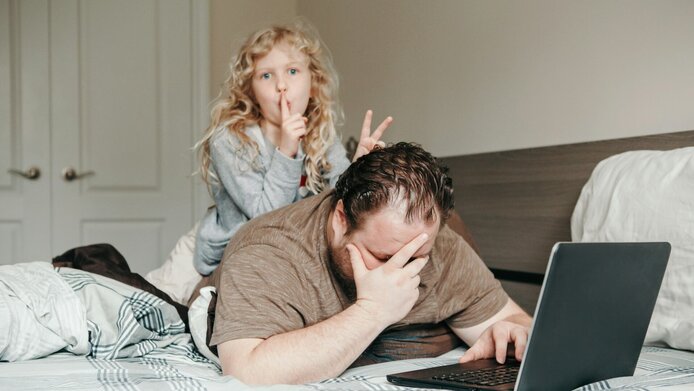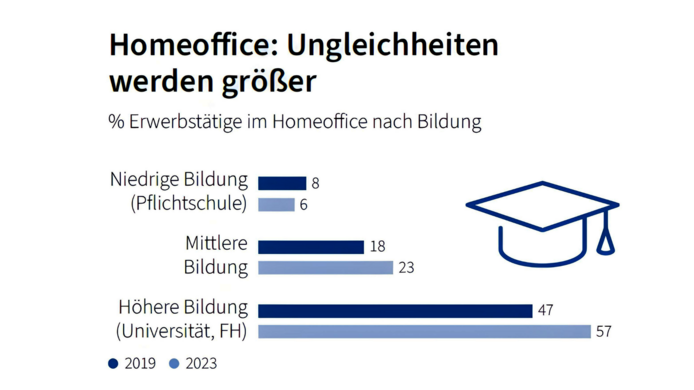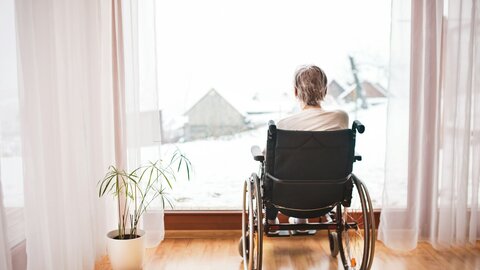Pandemic: old role models, new world of work

The coronavirus pandemic hit many people unprepared and turned their working lives upside down. One of the most substantial changes was the fact that working from home became a necessity, increasing steeply during several lockdowns. Sociologist Caroline Berghammer from the Vienna Institute of Demography at the Austrian Academy of Sciences has investigated how paid and unpaid work developed in Austria during this time and what changes have survived.
For her three-year project (2021–2024), which was funded by the Austrian Science Fund FWF, Berghammer and her team used data from the microcensus – surveying 22,500 households in Austria every quarter – for her analysis of gainful employment and working from home. Data from the Austrian Corona Panel served as a basis for questions on childcare and housework.
Working from home: a trend that has come to stay
During the lockdowns, roughly 30 percent of the labor force worked from home. This proportion has remained largely stable since then, even though the details have changed: Whereas it was often an emergency solution during the pandemic, working from home has now become entrenched as a regular and functioning working model in many companies. This said, many people do not work from home five days a week but instead use hybrid models of one or two days a week.
Does it make a difference how frequently people opt for working from home depending on whether they have children or not? Exploring this question, the research team arrived at the following results: women and men without children work from home less often than those with children, but the increase in working-from-home days of around 10 percentage points between 2019 and 2023 was roughly the same for all groups. “Working from home means an improvement in the work-life balance for many people, but it is not a feasible option for everyone,” says Berghammer.
Reinforcing social inequalities
The distribution of unpaid domestic and family work is a central issue in Berghammer's research. Although the pandemic led to working arrangements that hardly existed in Austria before, such as fathers working part-time, this did not bring about a change in traditional employment patterns in the long run. Short-time work and unemployment – especially among the less educated – were among the factors that initially changed the situation. The proportion of couples in which both parents worked part-time increased by seven percentage points at the beginning of the pandemic. During the same period, the proportion of couples in which mothers worked more hours than fathers also increased, especially among the more highly educated. “We observed a role reversal,” notes the sociologist.
How did couples distribute paid and unpaid work during the COVID-19 lockdowns in Austria? What were their arrangements regarding work place and non-standard working hours? Which policy implications can be drawn in order to reduce families’ strain?
The sociologist and principal investigator Caroline Berghammer examined changes in paid and unpaid work among couples in Austria between 2019 and 2021. The project is based on data from the Austrian microcensus and the Austrian Corona Panel Project (ACPP).
More about the basic research project
However, not all employees were able to benefit equally from the option to work from home. This option was open most of all to higher-educated individuals in non-manual jobs. People whose jobs entail direct customer contact or physical work – such as the retail or production sectors – still had to work on site. The current research findings show how these pre-existing social inequalities became further entrenched during the pandemic. Workers with higher levels of education are far more likely to work from home than those with lower levels.
Traditional gender roles persist
The scientific evaluations reveal that the pandemic caused a temporary shift: fathers took on more childcare, especially when they were working from home or on short-time work. However, the bulk of housework and childcare remained the mothers’ domain. “During the first lockdown, mothers devoted a particularly substantial amount of time to their children – up to eight hours a day,” reports Berghammer. In total, they spent an average of 13 hours on domestic and professional duties. This was reflected in women’s level of contentment with their lives. “During the pandemic, women's life satisfaction was consistently lower than that of men.”
Missed opportunities?
The pandemic had the potential to create more equality in terms of division of labor. For the time being, however, Berghammer's analyses show a different picture. Even though some men gathered novel experience with care work during this time, many families returned to traditional roles after the pandemic. “While some things changed in the short run, deeply entrenched ideas and institutional frameworks are difficult to break out of,” explains Berghammer.
Berghammer is following up on her research with funding from the European Research Council ERC. The next project is designed to clarify whether new patterns will be established in the long term through more flexible working models. One thing is certain: working from home depends heavily on the respective line of work and social status. The issue of gender equality will remain unresolved for as long as structures – from wage gaps to childcare options – do not fundamentally change.
Personal details
Caroline Berghammer has been heading the “Family and Labor Market” research group at the Vienna Institute of Demography of the Austrian Academy of Sciences (ÖAW) since 2025. She acquired her doctorate in sociology from the University of Vienna in 2010. In 2006/07, she attended the European Doctoral School of Demography at the Max Planck Institute for Demographic Research in Rostock, Germany. Between 2011 and 2025 she worked at the Department of Sociology at the University of Vienna, as of 2024 as an associate professor
Publications
Berghammer C., Riederer B.: Growing diversity in couples’ work patterns during the COVID-19 pandemic in Austria, in: Journal of Family Research 2024
Berghammer C.: Childcare and housework during the first lockdown in Austria: Traditional division or new roles?, in: Journal of Family Research 2022






